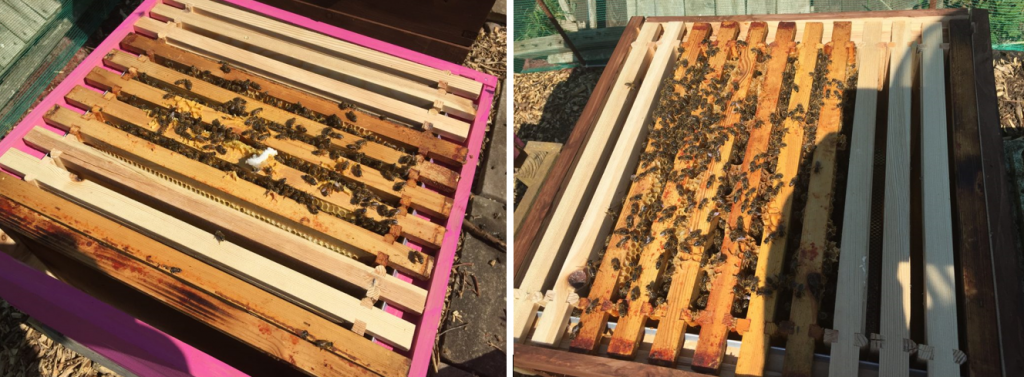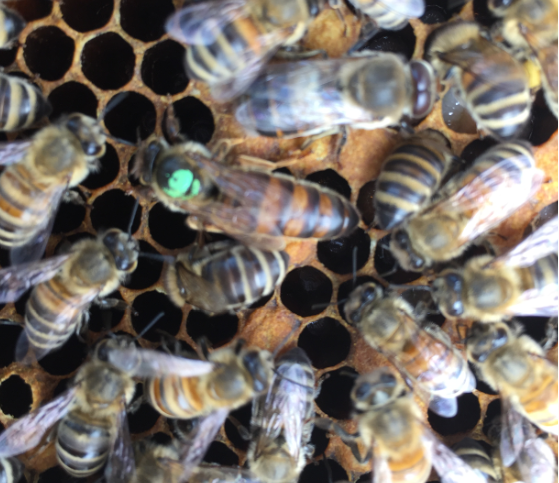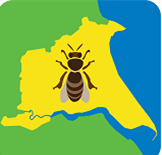Transferring bees from nucs to hives

Three days after the nucs arrived on the allotment, it was time to transfer the bees to their new homes, DIY style.
I’d watched several inspections which flowed smoothly but being on my own, with no one to ask questions of, was different for example, what was the best way to position the frames?
I’d read about the ‘hot’ and ‘cold’ way but looking down into the brood box I still got confused. It looks like confusion is going to be regular theme in these early days!
I decided to focus on the actual transfer process then go home to re-read the advice, but would it be ok to reposition later or would that end up confusing the bees as well? They were really calm and didn’t seem bothered about being disturbed. I hoped they’d be as forgiving of any errors too.

Looking at the frames, I could see a few honey stores at the edge of the outer frames in the pink nuc, but none in the white so they were probably hungry. I pierced holes in the lid of a jar of sugar syrup and balanced it upside down. Not having any wooden lats to hand I improvised with bits of bark but wasn’t sure if it went directly over a hole in the crown board, or to one side so the bees could creep underneath. The obvious isn’t always instinctive but I was pleased to think of using supers as temporary ekes.

It wasn’t a full inspection but I did take a quick look at each frame. I recognised larvae plus capped worker and drone cells but couldn’t see any pollen or eggs.
The pink nuc queen was marked and I found her on the outside of the last frame, her green dot telling me she was from 2019. Because the frames were full of capped brood, I wasn’t sure if she was looking for more space, but with no sign of any starter queen cells, I decided she was just making a point of moving away from me as I disrupted her home

There was no sign of the unmarked queen in the white nuc.
I knew if eggs could be seen, there’s no need to worry, but egg spotting was another challenge. I’m really short-sighted and tend to look over the top of my glasses to see close up but the veil meant I couldn’t get close enough. Also, many frames were covered with bees so it was difficult to see anything, never mind any tiny eggs inside of the cells. I forgot all about shaking the bees down into the box. This is what happens. Sometimes theory into practice needs a helping hand, but with hindsight they were probably being disrupted enough. I could learn the art of bee-shaking another time.

I made notes on the condition of each frame and wanted to take photos to study later but but it was hard to hold a frame and take a picture at the same time. Beekeepers not only need to multitask, they need additional hands to do it.
Placing the camera inside the box didn’t give the detail I wanted so I’ve ordered some frame holders. They won’t be the same as holding the frames up to the light so I may need to think this through some more. I think it’ll be a case of trial and error to see what works best for me and for the bees.

The final job this week was to make my own sugar syrup, rather than borrowing it. There’s lots of recipes online for 2:1 and 1:1 ratios, but they mix gallons, quarts and pints as well as millilitres, while comparing liquids and solids was cue for more confusion.
The relationship between newbie beekeeper and more experienced mentor is an important one. I had at least a dozen questions every day but didn’t like to keep asking, and also wanted to show I was trying to do my own research. In the end, I had to get in touch and Patrick advised 650ml of water to 1kg sugar, saying the language of 1:1 and 2:1 isn’t always useful. Lesson learned – should have asked sooner!
He also explained how new colonies are the exception to the general advice about stopping feeding when pollen and nectar supplies increase. My new bees needed energy to draw out the cells on the wax foundation. The sugar syrup would help them do this as well as provide additional stores. That explained why I was feeding at this time of year.

Once the transfer and feeding was complete, I could have sat and watched the bees all day. Going home, it felt strange to think of them getting going without me, but I knew they would carry on regardless. They’re independent colonies, doing their own thing.
Still, I was missing them already and looking forward to the first full inspection when I’d get to see them all again.


